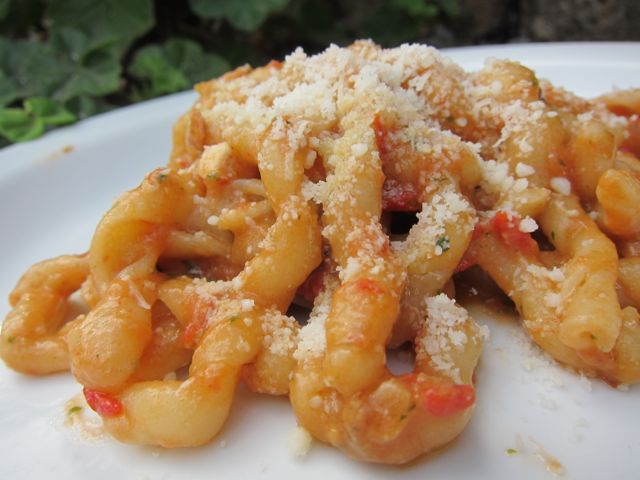
If you follow me on any sort of social media platform then you already know that I went to Pantelleria last week. I was invited to this tiny volcanic island stuck between Sicily and Tunisia by the folks at Oldways. I’ve been on about a dozen learning trips with this organization over the last 15 years to places like Puglia, Chios, Lesbos, Barcelona and even China. It’s through Oldways that I’ve learned most of what I know today about the health properties of the Mediterranean diet. In fact, it was Oldways that developed the Mediterranean Diet Pyramid and their trips – which invite chefs, journalists, nutritionists, scientists and importers to learn and exchange ideas and research – has resulted in the fact that you most likely have a bottle (or five) of olive oil in your pantry today.
I always end up learning something completely new on these trips, and this time was no different. The health properties of capers (who knew?) and how best to preserve zibibbo grapes into jam will be coming up on the blog later this week and next.
But one of the first things I learned about Pantelleria had to do with geography. When I first got invited I sent an immediate Yes! And then thought: where the hell is Pantelleria? I knew it was an island off Sicily where people like Sting and Madonna hang out. What I didn’t realize was that it was WAY south of Sicily, closer to Africa than to any Italian coast.
I quickly learned that while there is plenty of influence from Africa (couscous for instance, and the zibibbo grape variety) there is much more give and take with Sicily, especially from a culinary point of view.
One of the many cooking lessons we attended was conducted by a visiting troupe of Trapanese from the mainland. Trapani is the Sicilian city closest to Pantelleria and the port where the ferry goes to, and many recipes make their way across the sea.
The cooking lesson itself was one of those surreal press trip kind of moments where you think, what is a chef from Trapani doing standing in a winery in Pantelleria giving a cooking lesson while about 40 journalist take notes, photographs and videos of this totally artificial set up?
But like everything else on the information-packed five days, the lesson turned out to be brilliant. Pesto Trapanese was always one of those things I never really ‘got’ when I read recipes. I fluently speak the concept of traditional pesto, but I never understood how you could add tomatoes to the mix and not have it turn into a mushy mess. I had always imagined a distant sort of raw tomato sauce cousin to the better known, thick and pungent Genovese pesto.
Seeing this chef put on his ‘pesto show’, complete with staged ingredients and spotless mortar and pestle finally cleared up the mystery.
First of all the ingredients. Like regular pesto, basil plays a starring role, as does garlic. But the main thickening agent here are not pine nuts from the Ligurian coast, but Sicilian almonds (both toasted and untoasted)
Once these are crushed together with a bit of salt, garlic and just enough olive oil to bind it, the tomatoes are added.
And here is the important part: just a few of the most intense tasting cherry tomatoes are added. These are local beauties and so have been grown in the unforgiving harsh heat of Sicily. This results in a thick skin, minimal juice and intense flavor. Cut in half, they are added to the mix and crushed until they are perfectly amalgamated.
Then – slowly slowly- just as in regular pesto, the oil is drizzled in and mixed until the result is an extremely thick, pesto-like mixture of uniquely Sicilian flavors.
Like pesto from Genoa, cheese in involved. But instead of incorporating Parmesan cheese directly into the mix, in Trapani a sharp pecorino is added in hefty doses atop the already sauced pasta.
Although the changes from traditional pesto seem minimal (almonds and tomatoes) the resulting taste is completely different. The almonds add a unique sweetness and the tomato’s acidity makes it sing. The sharp taste of the sheep’s milk pecorino balances out everything.
And like regular pesto it’s all about the ingredients. While you can get almonds and garlic all year long, the tomatoes and basil make this an intensely summer dish. The perfect way to use up the rest of your basil, right? 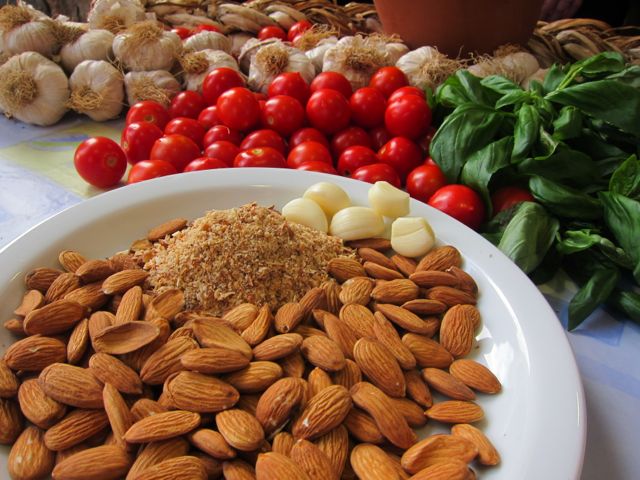
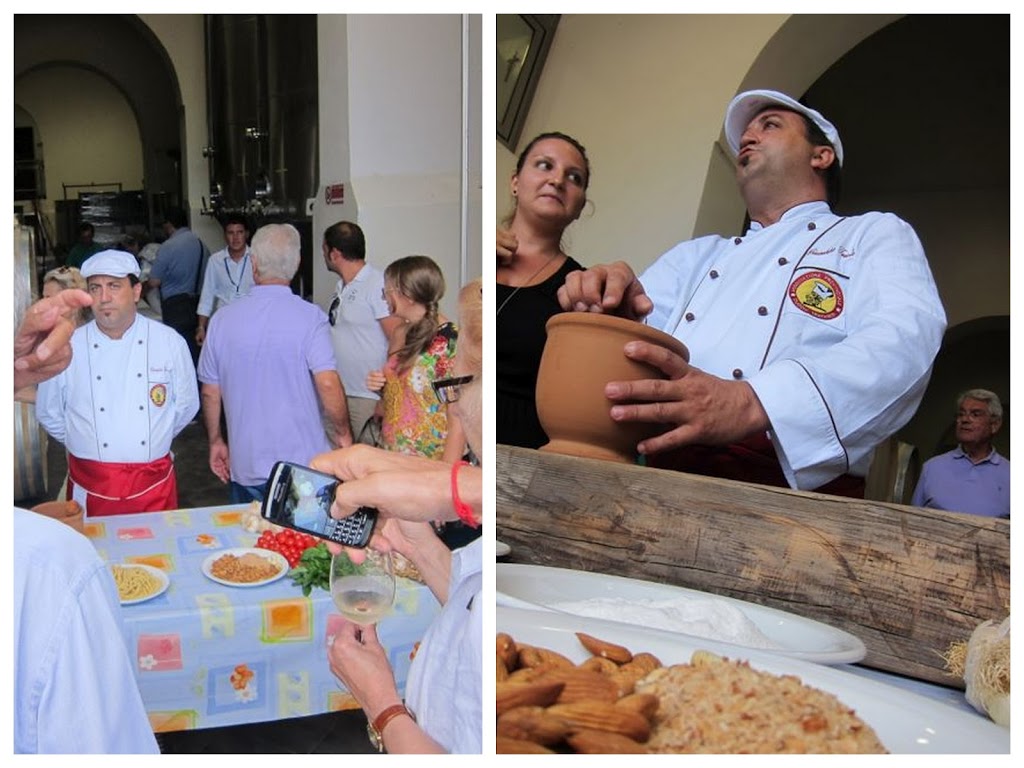
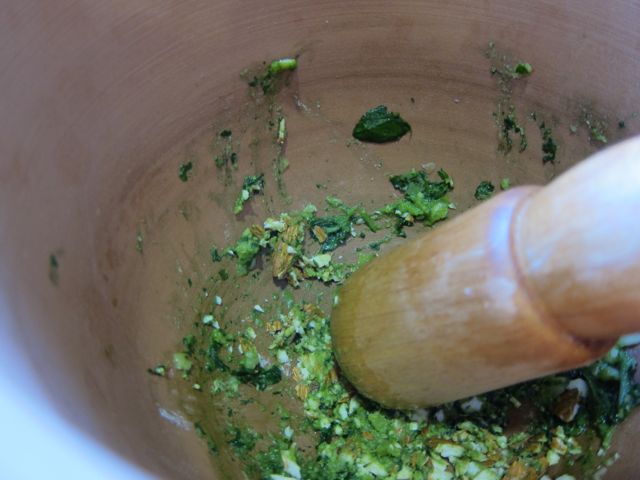
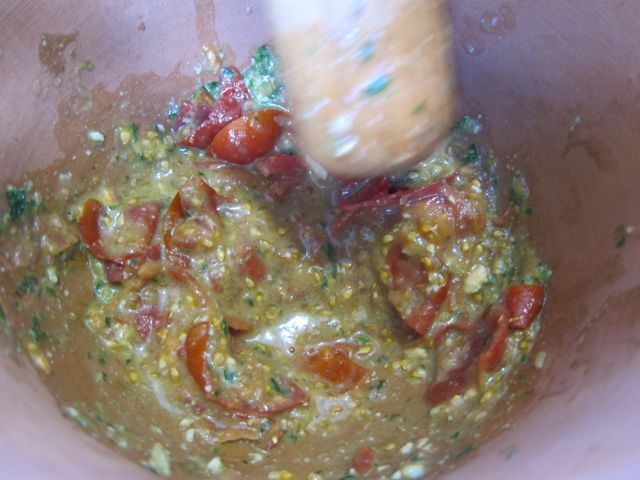
Pesto Trapanese
1 bunch fresh basil
4 cloves garlic
1/4 cup unsalted almonds*
6 cherry tomatoes
1/3 cup olive oil
freshly grated pecorino cheese
salt
pepper
1 pound / 1/2 kilo of pasta
*A lot of recipes call for peeled almonds, but here only almonds with their skin were used. Some toasted and some not. I’d say you can use whatever is easiest for you as long as they are fresh and good quality almonds. Just make sure they are not salted.
In a mortar and pestle put the garlic, almonds, basil and salt. Add 1 tablespoon olive oil and mash until well blended (you can do this in a food processor too, just don’t over mix)
When everything is very smooth, add the tomatoes, which you’ve cut in half. If you are using a mortar and pestle be careful, since the tomatoes tend to squirt out juice.
Mix until the tomatoes have become incorporated.
Slowly start to add oil, mixing all the time so that the oil is well amalgamated. Taste and adjust for salt and pepper.
The pesto can be made ahead of time and actually gets better after a few hours. Just make sure you cover it with cling film so that the basil doesn’t oxidize.
Bring a large pot of salted water to boil, add pasta and cook until done. Drain and dress with pesto.
To serve place in individual bowls and top with grated sharp pecorino cheese.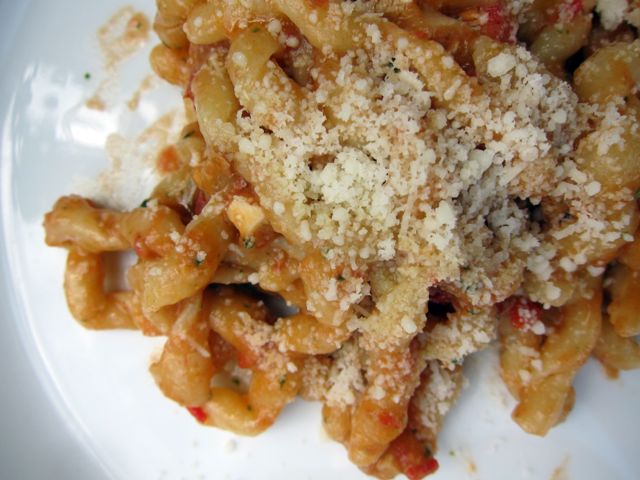
Lucky you. Great article and fab photos. Will have to try this. Oldwas sounds like a very interesting organization. Enjoyed this very much.
I am drooling over this photo. I can’t wait to try this variation soon with the last of the tomatoes and basil from the farmer’s market. This recipe is just in the nick of time!
I really, really appreciated that you showed up the “dog and poney” aspect of some press trips–but oooh when this is the trick! Wow.
As always, I can’t thank you enough for sharing your experiences and knowledge, Elizabeth. Your blog remains one that I am truly happy to each night. I sit down with my glass of something and enjoy. Merci mille fois!
Heather
Oops, missing a “read” there. Trust me, this is my first glass of something! 😉
That looks AMAZING!